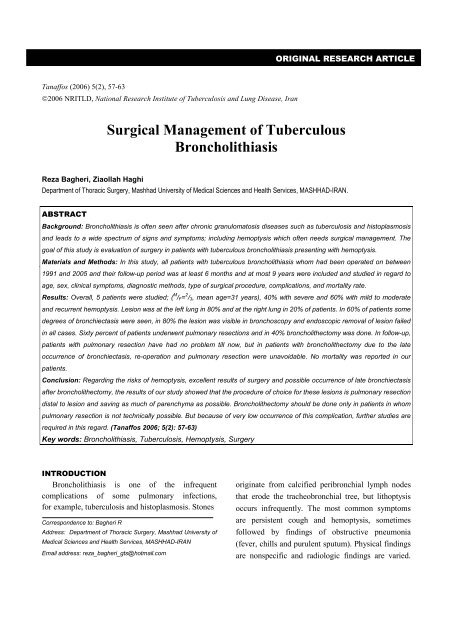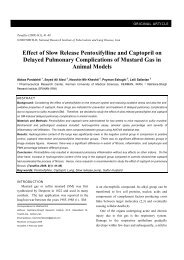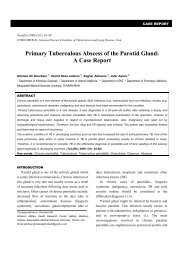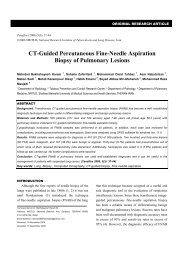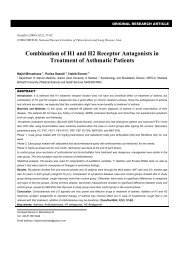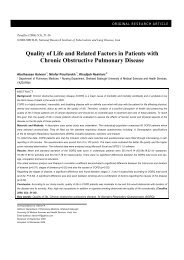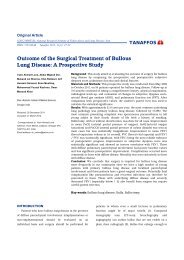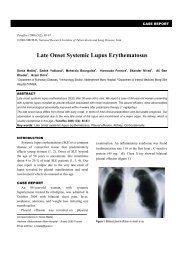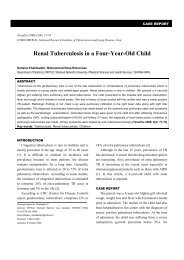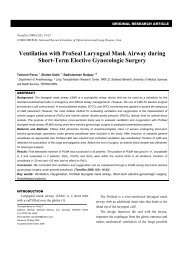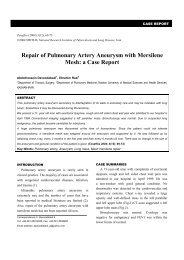Surgical Management of Tuberculous Broncholithiasis - Tanaffos
Surgical Management of Tuberculous Broncholithiasis - Tanaffos
Surgical Management of Tuberculous Broncholithiasis - Tanaffos
Create successful ePaper yourself
Turn your PDF publications into a flip-book with our unique Google optimized e-Paper software.
ORIGINAL RESEARCH ARTICLE<br />
<strong>Tanaffos</strong> (2006) 5(2), 57-63<br />
©2006 NRITLD, National Research Institute <strong>of</strong> Tuberculosis and Lung Disease, Iran<br />
<strong>Surgical</strong> <strong>Management</strong> <strong>of</strong> <strong>Tuberculous</strong><br />
<strong>Broncholithiasis</strong><br />
Reza Bagheri, Ziaollah Haghi<br />
Department <strong>of</strong> Thoracic Surgery, Mashhad University <strong>of</strong> Medical Sciences and Health Services, MASHHAD-IRAN.<br />
ABSTRACT<br />
Background: <strong>Broncholithiasis</strong> is <strong>of</strong>ten seen after chronic granulomatosis diseases such as tuberculosis and histoplasmosis<br />
and leads to a wide spectrum <strong>of</strong> signs and symptoms; including hemoptysis which <strong>of</strong>ten needs surgical management. The<br />
goal <strong>of</strong> this study is evaluation <strong>of</strong> surgery in patients with tuberculous broncholithiasis presenting with hemoptysis.<br />
Materials and Methods: In this study, all patients with tuberculous broncholithiasis whom had been operated on between<br />
1991 and 2005 and their follow-up period was at least 6 months and at most 9 years were included and studied in regard to<br />
age, sex, clinical symptoms, diagnostic methods, type <strong>of</strong> surgical procedure, complications, and mortality rate.<br />
Results: Overall, 5 patients were studied; ( M / F= 2 / 3, mean age=31 years), 40% with severe and 60% with mild to moderate<br />
and recurrent hemoptysis. Lesion was at the left lung in 80% and at the right lung in 20% <strong>of</strong> patients. In 60% <strong>of</strong> patients some<br />
degrees <strong>of</strong> bronchiectasis were seen, in 80% the lesion was visible in bronchoscopy and endoscopic removal <strong>of</strong> lesion failed<br />
in all cases. Sixty percent <strong>of</strong> patients underwent pulmonary resections and in 40% broncholithectomy was done. In follow-up,<br />
patients with pulmonary resection have had no problem till now, but in patients with broncholithectomy due to the late<br />
occurrence <strong>of</strong> bronchiectasis, re-operation and pulmonary resection were unavoidable. No mortality was reported in our<br />
patients.<br />
Conclusion: Regarding the risks <strong>of</strong> hemoptysis, excellent results <strong>of</strong> surgery and possible occurrence <strong>of</strong> late bronchiectasis<br />
after broncholithectomy, the results <strong>of</strong> our study showed that the procedure <strong>of</strong> choice for these lesions is pulmonary resection<br />
distal to lesion and saving as much <strong>of</strong> parenchyma as possible. Broncholithectomy should be done only in patients in whom<br />
pulmonary resection is not technically possible. But because <strong>of</strong> very low occurrence <strong>of</strong> this complication, further studies are<br />
required in this regard. (<strong>Tanaffos</strong> 2006; 5(2): 57-63)<br />
Key words: <strong>Broncholithiasis</strong>, Tuberculosis, Hemoptysis, Surgery<br />
INTRODUCTION<br />
<strong>Broncholithiasis</strong> is one <strong>of</strong> the infrequent<br />
complications <strong>of</strong> some pulmonary infections,<br />
for example, tuberculosis and histoplasmosis. Stones<br />
Correspondence to: Bagheri R<br />
Address: Department <strong>of</strong> Thoracic Surgery, Mashhad University <strong>of</strong><br />
Medical Sciences and Health Services, MASHHAD-IRAN<br />
Email address: reza_bagheri_gts@hotmail.com<br />
originate from calcified peribronchial lymph nodes<br />
that erode the tracheobronchial tree, but lithoptysis<br />
occurs infrequently. The most common symptoms<br />
are persistent cough and hemoptysis, sometimes<br />
followed by findings <strong>of</strong> obstructive pneumonia<br />
(fever, chills and purulent sputum). Physical findings<br />
are nonspecific and radiologic findings are varied.
58 <strong>Surgical</strong> <strong>Management</strong> <strong>of</strong> <strong>Tuberculous</strong> <strong>Broncholithiasis</strong><br />
Complications include formation <strong>of</strong> a fistula between<br />
the respiratory tract and the esophagus or aorta and<br />
obstructive pulmonary symptoms and hemoptysis.<br />
Treatment ranges from conservative management<br />
(simple observation) to bronchoscopic removal <strong>of</strong><br />
broncholithiasis and thoracotomy for patients in<br />
whom complications such as hemoptysis, obstructive<br />
pneumonia or secondary bronchiectasis develop. (1)<br />
In our country (Iran) the most common cause <strong>of</strong> this<br />
problem is tuberculosis which is endemic here. The<br />
goal <strong>of</strong> this study was evaluation <strong>of</strong> surgical<br />
management <strong>of</strong> patients with broncholithiasis and<br />
hemoptysis due to tuberculosis.<br />
MATERIALS AND METHODS<br />
In a descriptive (case series) study from 1991 to<br />
2005, all patients with tuberculous broncholithiasis<br />
and hemoptysis in Quaem and Omid hospitals in<br />
Mashhad, were evaluated. Age, sex, the interval<br />
between the occurrence <strong>of</strong> lesion and diagnosis <strong>of</strong><br />
tuberculosis, the interval between the first<br />
hemoptysis episode and surgery, bronchoscopic and<br />
radiologic diagnosis <strong>of</strong> lesion, patients' sputum test<br />
for detection <strong>of</strong> tubercle bacilli, type <strong>of</strong> surgery,<br />
complications <strong>of</strong> surgery and mortality were all<br />
studied.<br />
RESULTS<br />
Overall, 5 patients were included in this study.<br />
Table 1 shows the characteristics <strong>of</strong> the patients. The<br />
M/F ration was 2/3. Mean age at the time <strong>of</strong><br />
admission was 31 years (range 18-58 yrs). Mean<br />
interval between the occurrence <strong>of</strong> hemoptysis due to<br />
broncholithiasis and termination <strong>of</strong> TB treatment was<br />
8.5 years (at least 6 and at most 10 years). Two<br />
patients with massive hemoptysis in the last refer<br />
were operated on but in the remaining 3 patients with<br />
mild to moderate recurrent hemoptysis surgery was<br />
done.<br />
All cases had undergone medical treatment for<br />
tuberculosis with definitive diagnosis but a few years<br />
later the treatment was terminated due to formation<br />
<strong>of</strong> broncholith and hemoptysis and because <strong>of</strong><br />
unsuccessful medical treatment surgery was<br />
indicated.<br />
Table 1. Characteristics <strong>of</strong> the patients<br />
Sex F M F M F<br />
Age (years) 18 25 33 58 21<br />
Duration between lesion<br />
occurance and diagnosis <strong>of</strong><br />
TB (years)<br />
6 8 9 10 9.5<br />
Type <strong>of</strong> hemoptysis Massive Mild to moderate Massive Mild to moderate Mild to moderate<br />
Location <strong>of</strong> lesion Left side Left side Left side Left side Right side<br />
Type <strong>of</strong> surgery<br />
Pulmonary<br />
resection: (left<br />
lower lobectomy)<br />
Pulmonary resection:<br />
(two segmentectomy<br />
in left lower lobe)<br />
Pulmonary<br />
resection: (left<br />
lower lobectomy)<br />
Broncholithectomy<br />
Broncholithectomy<br />
Complication No No No<br />
Secondary<br />
Bronchiectasis (second<br />
operation: left lower<br />
lobectomy +<br />
lingulectomy)<br />
Secondary<br />
Bronchiectasis (second<br />
operation: right lower<br />
lobectomy)<br />
<strong>Tanaffos</strong> 2006; 5(2):57-63
Bagheri R, et al. 59<br />
In all patients broncholithiasis was clearly visible<br />
in chest X-ray and CT-scan.<br />
The lesion was at the left side in 4 patients (80%)<br />
and at the right side in 1 patient (20%). In 3 patients<br />
(60%) in addition to broncholith, there were some<br />
degrees <strong>of</strong> bronchiectasis in segments distal to lesion.<br />
Figures 1 and 2 demonstrate the chest X-ray and CTscan<br />
<strong>of</strong> a 29-year old female with tuberculous<br />
broncholithiasis and hemoptysis.<br />
Diagnostic fiberoptic bronchoscopy was done in<br />
all patients and in 4 patients (80%) erosion <strong>of</strong><br />
broncholithiasis into the airway was clearly visible.<br />
Figure 3 shows the bronchoscopic view <strong>of</strong> the lesion<br />
in the same patient.<br />
Figure 1. Multiple broncholithiasis (adjacent to pulmonary artery and<br />
lower lobe bronchus).<br />
Figure 2. CT-scan <strong>of</strong> the same patient; bronchiectatic areas in the lower<br />
lobe are demonstrated.<br />
Figure 3. The bronchoscopic image <strong>of</strong> broncholithiasis<br />
Attempting to bronchoscopic removal was<br />
unsuccessful in all patients. Sputum tests for tubercle<br />
bacilli were done in all patients prior to surgery and<br />
all were negative.<br />
All patients underwent open surgery using<br />
posterolateral thoracotomy approach in 5th<br />
intercostal space. Three patients (60%) who had<br />
moderate to severe hemoptysis showed some degrees<br />
<strong>of</strong> bronchiectasis distal to lesion. In two patients<br />
(40%) left lower lobectomy and in one patient (20%)<br />
resection <strong>of</strong> two segments <strong>of</strong> the left lower lobe were<br />
done. Figure 4 shows the gross pathologic image <strong>of</strong><br />
the resected specimen.<br />
Figure 5 shows the radiographic image <strong>of</strong> the<br />
same patient after the operation.<br />
<strong>Tanaffos</strong> 2006; 5(2): 57-63
60 <strong>Surgical</strong> <strong>Management</strong> <strong>of</strong> <strong>Tuberculous</strong> <strong>Broncholithiasis</strong><br />
In the other two patients (40%), who had mild<br />
hemoptysis and no distal bronchiectasis in<br />
radiographic studies, only broncholithectomy and<br />
adjacent bronchial vessel ligation were done.<br />
Figure 6 shows a large broncholith within the inferior<br />
lobe bronchi.<br />
Figure 4. In gross pathologic image location <strong>of</strong> broncholithiasis is clearly<br />
visible.<br />
Figure 6. Chest X-Ray (AP and lateral view) <strong>of</strong> patient with large<br />
broncholithiasis which has been operated with broncholithectomy<br />
Figure 5. Postoperative radiographic image <strong>of</strong> the same patient after<br />
left lower lobectomy.<br />
At the follow up period <strong>of</strong> 6 months to 9 years, 3<br />
patients with pulmonary resection had no problem<br />
and were almost treated. But in 2 patients with<br />
broncholithectomy alone, reoperation was done due<br />
to severe bronchiectasis and related symptoms (in<br />
one 3 years later and in the other after 6 years). In<br />
one patient left lower lobectomy plus lingulectomy<br />
and in the other right lower lobectomy were done.<br />
These two patients have had no problem till now,<br />
including no bloody sputum.<br />
Figure 7 shows CT scan <strong>of</strong> the patient presented<br />
in figure 6 with broncholithectomy due to large<br />
broncholithiasis; the CT scan showed a delayed<br />
bronchiectasis in the left lower lobe and lingula,<br />
<strong>Tanaffos</strong> 2006; 5(2):57-63
Bagheri R, et al. 61<br />
presenting three years after the first surgery.<br />
Figure 7. Bronchiectasis in the left lower lobe and lingula presenting<br />
three years after broncholithectomy.<br />
In all patients, histopathologic examinations<br />
showed tuberculous broncholithiasis. Figure 8 shows<br />
the microscopic image <strong>of</strong> tuberculous<br />
broncholithiasis. No mortality was reported in our<br />
patients.<br />
Figure 8. Microscopic view <strong>of</strong> broncholitniasis: calcification (black<br />
arrow) and fibrotic capsule (white arrow) are seen.<br />
DISCUSSION<br />
<strong>Broncholithiasis</strong> is, in fact, an ossified or calcified<br />
material which has gone through bronchial lumen.<br />
The common causes <strong>of</strong> this lesion are tuberculosis<br />
and histoplasmosis.(2) It has a wide spectrum <strong>of</strong><br />
clinical manifestations; presenting with mild<br />
symptoms as cough and sometimes lithoptysis or<br />
complicated forms (3, 4) .<br />
Chemical composition <strong>of</strong> broncholith is very<br />
similar to bone; it contains 85-95% calcium<br />
phosphate and 7-10% calcium carbonate (5).<br />
Complications <strong>of</strong> broncholithiasis are different<br />
from a mild lithoptysis to more severe symptoms.<br />
One <strong>of</strong> the most dangerous complications <strong>of</strong> this<br />
lesion which almost always needs surgery is<br />
hemoptysis (6). For example, Stocia et al. reported a<br />
51-year-old man with massive hemoptysis and<br />
broncholithiasis who was operated on (7). Similar<br />
cases have been reported by Meyer et al. They<br />
mentioned that the cause <strong>of</strong> hemoptysis is erosion <strong>of</strong><br />
broncholithiasis through adjacent bronchial vessels<br />
which leads to severe and lethal hemoptysis in<br />
patients (8). Other complications which <strong>of</strong>ten need<br />
surgery in patients are obstructive pneumonia and<br />
secondary bronchiectasis, which can be presented<br />
with fever, chills, and purulent sputum (1).<br />
Another complication <strong>of</strong> broncholithiasis which<br />
<strong>of</strong>ten needs surgery is bronchoesophageal fistula<br />
which is dangerous and needs a difficult operation<br />
(9).<br />
Besides, broncholithiasis in some patients<br />
presents as middle lobe syndrome, and in all patients<br />
with such presentation, broncholithiasis should be<br />
considered (10).<br />
Radiographic and CT-scan images <strong>of</strong> tuberculous<br />
broncholithiasis are various but <strong>of</strong>ten enough to<br />
make the diagnosis. <strong>Broncholithiasis</strong> is strongly<br />
suggested at CT-scan when endobronchial or<br />
peribronchial calcified node is associated with<br />
findings <strong>of</strong> bronchial obstruction. Volume data<br />
acquisition by means <strong>of</strong> helical CT with sections less<br />
than 3 mm in thickness and multiplanar reformation<br />
along the bronchial tree are helpful in confirming the<br />
endobronchial location <strong>of</strong> the calcified material.<br />
Primary endobronchial infection with dystrophic<br />
calcification, hypertrophic bronchial artery with<br />
<strong>Tanaffos</strong> 2006; 5(2): 57-63
62 <strong>Surgical</strong> <strong>Management</strong> <strong>of</strong> <strong>Tuberculous</strong> <strong>Broncholithiasis</strong><br />
intramural protrusion, calcified endobronchial tumors<br />
and tracheobronchial disease with mural calcification<br />
may mimic broncholithiasis (2).<br />
Moreover, primary endobronchial actinomycosis<br />
rarely has images very similar to broncholithiasis. In<br />
a report by Seo et al. they performed bronchoscopy<br />
and biopsy in 2 patients with presentations <strong>of</strong><br />
broncholithiasis without history <strong>of</strong> granulomatosis<br />
disease and the diagnosis <strong>of</strong> actinomycosis was<br />
approved in them (11).<br />
Endoscopic findings consist <strong>of</strong> tracheobronchial<br />
distortion, inflammation, a visible broncholith, and<br />
bleeding. Occasionally, the patient may have<br />
endoscopic finding <strong>of</strong> a fistula in either the<br />
esophagus or the tracheobronchial tree (12).<br />
Treatment guidelines are controversial due to<br />
small number <strong>of</strong> case reports. It is <strong>of</strong>ten a consensus<br />
that in asymptomatic or mild forms <strong>of</strong> disease the<br />
patients can be only observed or the broncholithiasis<br />
can be removed bronchoscopically. Huang CC et al.<br />
reported successful removal <strong>of</strong> broncholithiasis in<br />
their patients (13). Similar results have been reported<br />
by Menivale et al. as in asymptomatic or mild forms<br />
<strong>of</strong> the disease they removed these lesions by<br />
bronchoscope. In fact this method was considered as<br />
the ideal treatment in these groups <strong>of</strong> patients (14).<br />
But in our study, endoscopic removal <strong>of</strong> lesion was<br />
not successful.<br />
The most detailed study about indications <strong>of</strong><br />
surgery was discussed by Trastek et al. in which 54<br />
patients with broncholithiasis were studied.<br />
Indications <strong>of</strong> surgery were: severe or recurrent<br />
hemoptysis, symptoms <strong>of</strong> distal obstruction<br />
(infection with fever and purulent sputum) or<br />
esophagobronchial fistula (15). Other investigators<br />
also mention the same indications for surgery (13,<br />
14, 16).<br />
There are different opinions in regard to surgical<br />
technique, from simple broncholithectomy to<br />
pulmonary resection and saving maximum <strong>of</strong><br />
parenchyma.<br />
Trastek et al. have had the most complete study<br />
and believe that operation <strong>of</strong> these patients is very<br />
dangerous due to severe adhesions. The standard goal<br />
<strong>of</strong> surgery is removal <strong>of</strong> calcified masses with<br />
destroyed lung or bronchi because <strong>of</strong> late<br />
complications <strong>of</strong> bronchi destruction (pneumonia,<br />
pulmonary abscess or bronchiectasis). Pulmonary<br />
resection and saving maximum <strong>of</strong> parenchyma is<br />
prefered to broncholithectomy (15).<br />
In another study, Cole et al. mentioned that<br />
attempting to pulmonary resection in these patients<br />
should be with control <strong>of</strong> proximal pulmonary<br />
vessels. In cases in whom pulmonary resection is not<br />
possible due to severe adhesion, opening <strong>of</strong> mass<br />
capsule and cauterizing its contents can prevent<br />
lethal complications during surgery (16).<br />
In our study, we performed pulmonary resection<br />
with saving maximum <strong>of</strong> parenchyma in 60% <strong>of</strong> our<br />
patients and in 40% simple broncholithectomy was<br />
done. But in the follow-up due to secondary<br />
bronchiectasis, we had to do re-operation and<br />
lobectomy was done in both, in fact simple<br />
broncholithectomy without pulmonary resection is<br />
not enough for treatment and is accompanied with<br />
late complications which lead to re-operation in these<br />
patients.<br />
In severely ill patients who can not tolerate the<br />
surgery and the lesion cannot be removed with<br />
bronchoscopy, use <strong>of</strong> Yttrium-aluminum has some<br />
benefits.<br />
CONCLUSION<br />
Because hemoptysis is a dangerous complication<br />
in tuberculous broncholithiasis, we recommend<br />
surgery in all patients since the endoscopic removal<br />
is <strong>of</strong>ten unsuccessful and leads to delay in the<br />
treatment course. Besides, due to chronicity <strong>of</strong><br />
lesions, the disturbing effects in the affected bronchi<br />
and preventing secondary bronchiectasis in patients,<br />
<strong>Tanaffos</strong> 2006; 5(2):57-63
Bagheri R, et al. 63<br />
our advice is to perform pulmonary resection distal to<br />
lesion with saving maximum parenchyma.<br />
Broncholithectomy alone is done only in patients in<br />
whom pulmonary resection is technically impossible.<br />
But because <strong>of</strong> the very low occurrence <strong>of</strong> this<br />
complication further studies are required in this<br />
regard.<br />
Acknowledgment<br />
Special thanks to Mozhgan Bahadori M.D and<br />
Mohammad Kalantary M.D for their cooperations.<br />
REFERENCES<br />
1. Haines JD Jr. Coughing up a stone. What to do about<br />
broncholithiasis. Postgrad Med 1988; 83 (3): 83- 4, 91.<br />
2. Seo JB, Song KS, Lee JS, Goo JM, Kim HY, Song JW, Lee<br />
IS, Lim TH. <strong>Broncholithiasis</strong>: review <strong>of</strong> the causes with<br />
radiologic-pathologic correlation. Radiographics 2002; 22<br />
Spec No: S 199- 213.<br />
11. Seo JB, Lee JW, Ha SY, Park JW, Jeong SH, Park GY.<br />
Primary endobronchial actinomycosis associated with<br />
broncholithiasis. Respiration 2003; 70 (1): 110- 3.<br />
12. Yi KY, Lee HK, Park SJ, Lee YC, Rhee YK, Lee HB. Two<br />
cases <strong>of</strong> broncholith removal under the guidance <strong>of</strong> flexible<br />
bronchoscopy. Korean J Intern Med 2005; 20 (1): 90- 1.<br />
13. Huang CC, Lan RS, Chiang YC, Lee CH, Shieh WB.<br />
<strong>Broncholithiasis</strong>: a neglected bronchial disease in this<br />
country. Illustration <strong>of</strong> three cases. Changgeng Yi Xue Za<br />
Zhi 1992; 15 (1): 44- 9.<br />
14. Menivale F, Deslee G, Vallerand H, Toubas O, Delepine G,<br />
Guillou PJ, Lebargy F. Therapeutic management <strong>of</strong><br />
broncholithiasis. Ann Thorac Surg 2005; 79 (5): 1774- 6.<br />
15. Trastek VF, Pairolero PC, Ceithaml EL, Piehler JM, Payne<br />
WS, Bernatz PE. <strong>Surgical</strong> management <strong>of</strong> broncholithiasis. J<br />
Thorac Cardiovasc Surg 1985; 90 (6): 842- 8.<br />
16. Cole FH, Cole FH Jr, Khandekar A, Watson DC.<br />
<strong>Management</strong> <strong>of</strong> broncholithiasis: is thoracotomy necessary?<br />
Ann Thorac Surg 1986; 42 (3): 255- 7.<br />
3. Larsen KR, Faurschou P. [<strong>Broncholithiasis</strong> and lithoptysis].<br />
Ugeskr Laeger 1994; 156 (26): 3904- 6.<br />
4. Ahmed N, et al. Lithoptysis. J Coll Physician Surg Pak<br />
2002; 12 (9): 558- 9.<br />
5. Dixon GF, Donnerberg RL, Schonfeld SA, Whitcomb ME.<br />
Advances in the diagnosis and treatment <strong>of</strong> broncholithiasis.<br />
Am Rev Respir Dis 1984; 129 (6): 1028- 30.<br />
6. Filippov VP, Ismailov ShSh, Shmelev MM, Mukhamedov<br />
KS. [<strong>Broncholithiasis</strong> complicated by pulmonary hemorrhage<br />
and abscessing pneumonia]. Probl Tuberk 1987; (3): 72- 3.<br />
7. Stocia IG, et al. <strong>Broncholithiasis</strong> and Massive hemoptysis: A<br />
case report. Eur Respir J 2003; 22(45): 153.<br />
8. Meyer M, O'Regan A. Images in clinical medicine.<br />
<strong>Broncholithiasis</strong>. N Engl J Med 2003; 348 (4): 318.<br />
9. Carvajal Balaguera J, Mallagray Casas S, Martinez Cruz R,<br />
Dancausa Monge A. [Bronchoesophageal fistula and<br />
broncholithiasis]. Arch Bronconeumol 1995; 31 (4): 184- 7.<br />
10. Vandenbos F, Passail G. [Middle lobe syndrome]. Rev<br />
Pneumol Clin 2005; 61 (4 Pt 1): 279- 81.<br />
<strong>Tanaffos</strong> 2006; 5(2): 57-63


